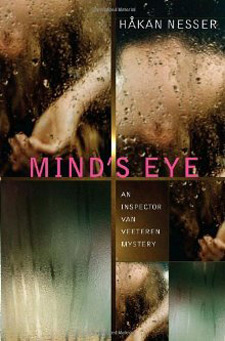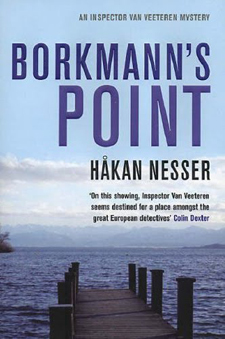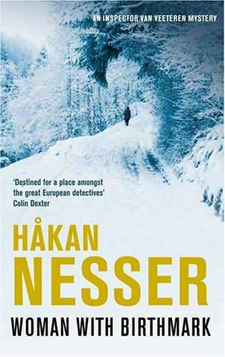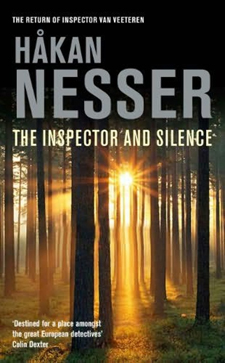
Like Mankell in his earlier days, Nesser writes police procedurals. His setting is a fictional town called Maardam. It’s in an unnamed country, but clearly northern Europe. His sleuth is Inspector Van Veeteren, a thirty-year veteran whose failings make him the stereotypical troubled cop. Yet stereotypes come to life in the hands of a skilled writer and that is what happens here.

The novels begin with The Mind’s Eye, proceed through Borkmann’s Point, The Return, Woman with Birthmark, and The Inspector and Silence, and wind up with The Unlucky Lottery (the English translation of that one is still forthcoming). They tend toward the serial-killer subgenre. Van Veeteren is often driven by the need to stop the killer before he (or she) kills again. Nesser uses a third-person narrative voice, so he can alternate back and forth between Van Veeteren’s perspective and that of the lurking villain, and we are often privy to the villain’s motivation. Usually there is a distinctive modus operandi, as in Woman with Birthmark, in which the victims are always shot twice in the heart and then twice below the belt—literally.

Geography shapes character. The Nordic people have adapted to their chilly, unforgiving lands, but their world view reflects the challenges their environment presents. In The Return, Van Veeteren recalls his father, who “unswervingly and inexorably . . . had inculcated into his son a certainty that we can never expect the least favor from life.” I was reminded of Independent People, the epic novel by the Icelandic Nobel laureate Halldór Laxness. Only hard work can guarantee any kind of survival in the world of Laxness’s fiction, but the effort to survive wrings the joy out of life.
Pleasure is suspect, as in Danish writer Isak Dinesen’s Babette’s Feast. If one gets too used to pleasure, one might lose the taste for work. And that mentality persists, even when the work ethic creates a civilization which, like modern Scandinavia, is the envy of many. On our own soil, we see the devotion to duty and suspicion of pleasure in Garrison Keillor’s Prairie Home Companion, which chronicles the society shaped by the Norwegian immigrants to Minnesota. Keillor’s humor probes the dark core of that world: no favors expected from the universe, but survival if one works unrelentingly.
My husband’s roots are Illinois German rather than Minnesota Norwegian, but he shares the Prairie Home Companion’s world view. “Life is what you make it,” uttered in a parody of a flat Midwestern drawl, has become a joking tagline in our marriage. It’s a quote from his mother, who invoked the phrase often as he was growing up.

In fact, his world is a Chandleresque world, and that brings us back to noir. Chandler and Hammett came by their dark world view, with its laconic style and slippery moral categories, by way of Hemingway. World War I created a lost generation, disillusioned in the wake of the Great War. In an uncaring universe, where God seemed dead, it is left to Chandler’s lonely hero to right wrongs. Why? The impulse comes from within himself: because life is what you make it. The same is true of Hakan Nesser’s appealing sleuth, Van Veeteren.
Peggy Ehrhart is the author of Sweet Man Is Gone (2008) and Got No Friend Anyhow (2011), featuring blues-singer sleuth Elizabeth “Maxx” Maxwell. Sweet Man Is Gone is now available on Kindle and in other ebook formats.

I have never even opened a Stieg Larsson book. From what I read about them, I didn’t think I’d be interested. Nesser, however, seems to have developed a character–Van Veeteren–that I would enjoy. I always like a protag who wears duty and responsibility with honor.
I think the Steig Larsson books suffered from an all-too-common practice in crime fiction, that of a nasty prologue, in the hope that it will entice the reader. Not, in my case. (I don’t recall this about book 1 but certainly do in book 2). I read a great deal of Scandinavian fiction including Nesser and S Larsson, and admit to enjoying the Larsson books – very exciting with lots of good things about them, but they needed better editing.
A lot of these Swedish mysteries center on abuse of women.
I read the “The Girl with the Dragon Tatoo” Enjoyed it but did not feel the need to read anymore Larsson books. I am in love with the entire Wallander series but I woud say that is suffers from too much grim Wallander and never plays up the other characters. They are only there to fetch information. Mankells’ books never have a funny moment or line in the series to break up the depression which is a shame. But the writing is good. Not in love with the daughter novel but I am told the author will not write any more about her after the death of the Swedish actress who played her in the TV series.
Hakan Nesser is a breath of fresh air. He has his flaws which make him human but he is smart and he is not hopelessly trapped in depressing habits like Wallander that overtake the police investigation.
I’m delighted to hear that there are others who feel Mankell’s series lost something when Linda took over as the protagonist. For all his gloominess, there was something kind of sexy about Kurt. And, about Stieg, I really agree that the nasty prologue is a turnoff. I suppose the aim is to grab the reader right away, but I personally am not grabbed by scenes of torment. I’m grabbed by meeting a character I want to get to know. Speaking of wanting to know people, I understand that Nesser lived briefly in New York and I’m sorry I was not yet a fan back then.